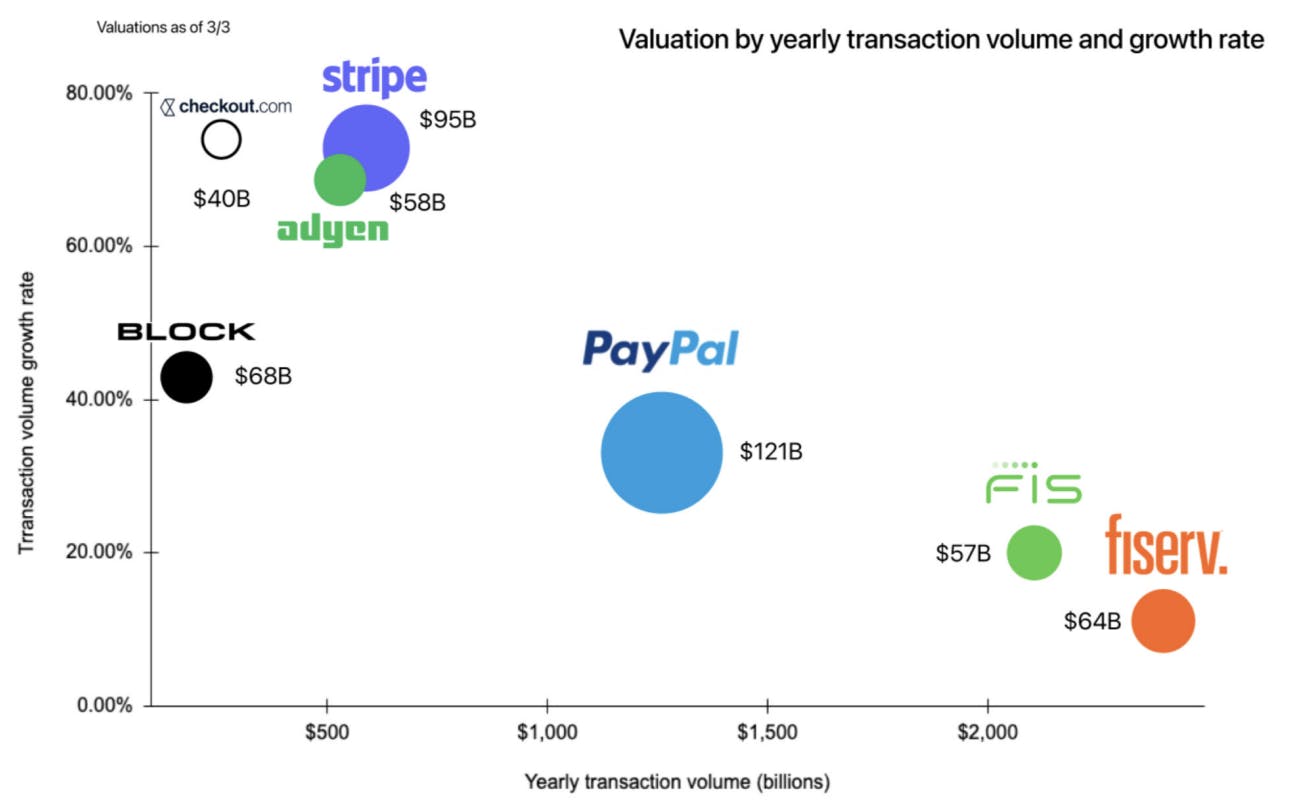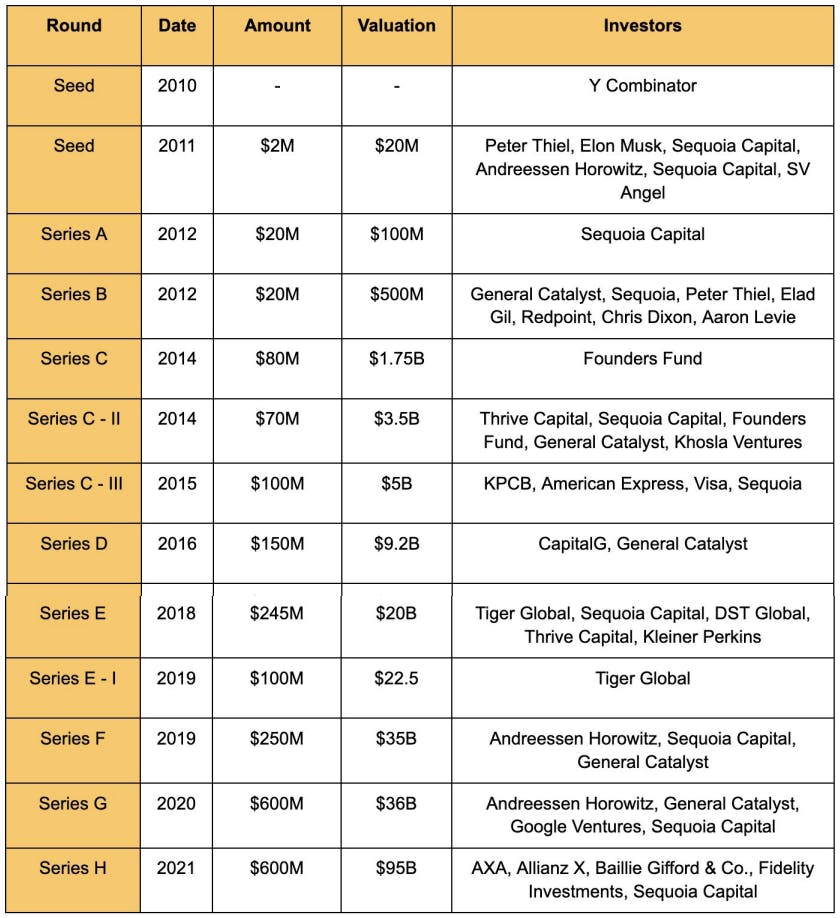
Revenue
$5.11B
2024
Valuation
$91.50B
2025
Growth Rate (y/y)
28%
2025
Funding
$9.81B
2025
Revenue
Sacra estimates that Stripe's net revenue grew 28% to $5.1B in 2024, up from $4B in 2023, and returned to profitability for the full year.
Stripe’s core checkout stack remains the growth engine, converting ~3% gross fees into a 0.40 % net take-rate after interchange, network, and partner costs.
With court-mandated cracks in Apple’s 30% commission on App Store purchases and Stripe’s dominance in digital payments, $8-10B of incremental iOS GMV could be poised to migrate to Stripe in 2025.
Valuation

Stripe reached a valuation of $91.5 billion in February 2025 through a secondary tender offer for employees and early investors, nearly matching its 2021 peak of $95 billion. This valuation reflects a significant rebound from its $50 billion Series I round in March 2023.
The company has raised approximately $9.4 billion in total funding since its founding in 2010. Major investors include Sequoia Capital, Andreessen Horowitz, Founders Fund, and Thrive Capital.
At its February 2025 valuation of $91.5 billion, Stripe is valued at approximately 16.3x its 2024 net revenue of $5.6 billion.
Product

Stripe is building an end-to-end platform for commerce on the internet. In addition to their core business around payments acceptance, Stripe also offers card issuing and banking-as-a-service (BaaS) via their new Treasury business. To deliver those services, Stripe partners with financial institutions like Wells Fargo, Cross River Bank, Regions Bank, Evolve Bank, Barclays, Goldman Sachs, and Citi. While those financial institutions provide the underlying infrastructure, Stripe builds products and services on top, like Terminal for in-person payments, Capital for lending-as-a-service, and Atlas for start-up incorporation.
Product-market fit
Stripe found their initial traction around an API that made it easier for merchants to start taking payments online. Before Stripe, both charging for items and paying for them online had poor user experiences. Companies would have to spend days to weeks setting up merchant accounts, dealing with regulations, compliance, and payment card issuers, and verifying the identities of people trying to buy from them—and that complexity and difficulty reflected on the consumer side. Stripe, in contrast, wrapped all the logic of collecting card payment details, securely storing them, and using them to charge customers for products within an elegant, straightforward Javascript library and an API designed for developers.
But true product-market fit, according to Stripe co-founder and CEO Patrick Collison, came from the products that the Stripe team built on top of that initial API—like Stripe Connect, which was built to help marketplaces like Instacart, Uber, Lyft, Postmates, and Shyp facilitate transactions on their platforms. As these platforms took off and grew at massive rates, Stripe grew as well. Today, Connect is likely one of the biggest contributors to Stripe’s revenue, with Shopify alone doing about $108 billion per year in volume through the platform, alongside other massive platforms like Lyft and Uber.
Go-to-market
Stripe’s developer-first approach enabled them to start with a bottom-up sales motion that stood in contrast to the enterprise sales cycle typical of incumbent online payment processors that were sold top-down and typically, to the CFOs of an organization. Stripe keyed into an evolution in how buying decisions were made, particularly in tech-forward startups, and as a result, was able to grow fast without building an outbound sales team. Meanwhile, when compared to other bottoms-up products like PayPal or Google Checkout, Stripe simply made their product easier to use.
Ecosystem
Stripe has generally looked to grow their ecosystem by layering new products on top of their core payments API layer, for example:
- Connect: for marketplaces and platforms to manage the movement of funds between different parties—for Uber, for example, which had a more complex use case than a conventional 1:1 ecommerce sale in needing to transfer payments between itself, riders, and drivers
- Billing: for subscription-based ecommerce companies to collect recurring payments from their users and manage different pricing models, competitive with the functionality of products like Zuora
- Issuing: for companies to issue virtual corporate cards with configurable spending limits and permissions as well as programmatically to generate cards as part of a product, like offering gig workers immediate access to earned funds via a car
- Lending: for SMBs using Stripe for payments, Stripe Lending allows those businesses to borrow cash, while Stripe can use their access to their financial data to price the risk of lending to them
These and other products increase lock-in by expanding the range of services that Stripe users can access on the platform. Critically, they also increase the speed at which a new fintech company can get up and running and offering financial services to their own users.
With the consumerization and digitization of finance, it has become more and more normal for non-fintech apps to offer certain banking services to their users, whether in the form of virtual cards, lending, or other functions. Stripe’s banking-as-a-service capabilities allow startups to offer these kinds of services out of the box. Lastly, staying within that Stripe ecosystem benefits companies by enabling them to build new kinds of products that wouldn’t be possible without the range of services offered by Stripe.
For example, companies who issue cards using Stripe Issuing can give contractors and gig workers access to their earnings instantly via Stripe Treasury, enable individual users on their platform to issue their own cards using Connect, and manage spending limits and allowable merchant categories from the same Stripe dashboard where they manage the rest of their payments stack.
Competition

In its core ecommerce payments provider business, Stripe competes with public companies like PayPal (Braintree), Adyen, Worldpay, Global Payments, and Fiserv (First Data), and privates like Revolut and Checkout.com.
International
Stripe already has international competitors that have geography-specific focus, like Adyen and Checkout.com in Europe. These regional rivals have benefited from heterogenous payments markets—whereas Stripe flourished in the U.S. where credit card acceptance rates are high, Adyen focused on supporting alternative payment methods from its inception, which helped it pick up adoption in Europe. Adyen and Checkout.com are also notable for building with a different type of go-to-market approach than Stripe. From launch, Adyen has had a focus on cross-border commerce, while Stripe has historically been more U.S.-focused with its product.
Checkout.com, on the other hand, has had more of mid-market, top-down focus. As of 2021, 3% of Stripe worked in sales, while a full 13% of Checkout.com worked in sales. It’s likely that over time, we’ll continue to see more and more companies emerge around the world to tackle payments in their specific geographies, especially given the relative lack of barriers to entry for well-funded competitors and the lack of network effects in the payments business.
Ecosystem
Stripe’s biggest threat on the ecosystem side is two-fold: there’s the risk of new players emerging, breaking off pieces of Stripe’s business and doing them better, and there’s the longer-term risk that a more modularized, primitives-centered approach is going to be better at facilitating the next biggest fintech-related consumer experiences.
Today, companies getting traction going after individual slices of Stripe’s business include:
- Card issuing: Lithic, Highnote, and Apto Payments
- Taxes: Anrok
- Corporate cards: Ramp and Brex
- Payment facilitation: Finix
These companies are indexing on interoperability and trying to build a sustainable ecosystem of products that sit outside Stripe.
Lithic, for example, has partner programs with Canopy (lending), Sila (ACH), Wyre (crypto), Dwolla (payments), and Peach (lending). Between them, they share documentation and support to help users get up and running stitching these different fintechs together in their product. What they’re betting on, fundamentally, is that this kind of modularized approach with many different “best-in-class” point solution providers is going to capture many of the best and fastest growing companies in the future—simply because they can enable novel product experiences where platforms like Stripe look to help companies with repeatable playbooks.
TAM Expansion
Stripe has a few core expansion opportunities:
- Market growth via international expansion
- Growth of ecosystem around payments
- Disrupting existing payments infrastructure
International


Around 5 out of 6 new internet users come from outside of Western Europe and North America, which means that emerging markets present a significant growth opportunity for Stripe’s acquiring business—both in terms of merchants who need to be able to accept payments and customers who want to make online purchases.
Internationally, Stripe competes with companies like Adyen ($ADYEY), Checkout, and Tencent’s WeChat ($TCEHY).
Today, Stripe operates in 46 countries, which is more than Adyen, and roughly at parity with major global payments processors like Fiserv, Global Payments, and FIS.
Some of Stripe’s international expansion will come through acquisitions. In 2020, Stripe acquired the Nigerian fintech startup Paystack—and its 60,000 customers—as part of a bigger move into the African continent.
Also in 2020, Stripe led the Series A for the Philippine digital payments business PayMongo, which only launched in 2019 with the goal of bringing more businesses in the Philippines online.
Overall, by acquiring or building their way into other markets internationally, Stripe can grow their customer base and drive increased revenue.
Ecosystem
If Stripe continues on their current trajectory in terms of building out additional use cases like billing, invoicing, and subscription management in the finance back-office, they have the opportunity to further grow their average revenue per customer and develop a stickier product through better lock-in.
That expansion could include use cases like:
- Tax: Today, in most parts of the world, Stripe Tax calculates how much you owe—but the opportunity remains for Stripe to build or buy its way into competition with end-to-end tax management SaaS like Avalara
- Subscription management: While Stripe offers subscription management via their Billing product, standalone products like Chargebee offer more fine-grained control via things like customized prices
- Expense management: Like Brex, Ramp, and Expensify, Stripe could make it easier for companies to monitor and manage their internal spend, particularly in combination with their Issuing product
Stripe has advantages due to the ecosystem they’ve already built that could make this a powerful avenue of future growth. Since new products in tax or expense management could integrate with a customer’s existing use of Stripe for billing or a corporate card, using Stripe as an end-to-end finance back-office platform could provide significant efficiencies for users.
Infrastructure

Today, Stripe operates as an “open loop” network (pictured), named that because it relies on existing financial infrastructure (like Visa and Mastercard) rather than attempting to replace it. Every bank issuer and bank merchant on those networks can send payments through Stripe, and Stripe benefits from levying a small tax on that entire long tail of activity.
There is, however, a growth case where Stripe looks to transition itself into a “closed-loop” network and directly challenge Visa and Mastercard in an effort to build the “5th” network (after Visa, Mastercard, Discover and American Express) which would enable them to capture, interchange, and deliver even more compelling unit economics for their merchants.
Building a closed-loop network would imply putting together a system that handles every transaction step in between the consumer and merchant. PayPal is the best example of this kind of online, closed loop in the United States—though they do integrate with other parties, you have the ability to deposit money into PayPal and transfer those funds elsewhere solely through PayPal.
The upshot is far better unit economics. If a customer pays for something from a Block Seller using a credit card, Block concedes 3% of the purchase price to the credit card company processing the transaction. On the other hand, if they can simply take Cash App as the method of payment for every transaction on the platform, they would be able to significantly increase their take rate.
One of the core challenges with building a closed-loop network is that it requires acquiring both merchants and consumers. PayPal’s acquisitions of Braintree (B2B) and Venmo (B2C) helped them build their network, while Block’s Cash App (B2C) and support for Sellers (B2B) have done the same.
Stripe, today, has no consumer offering. However, with their Issuing product, they are moving into the direction of trying to capture both sides of the transaction, albeit in a strictly B2B sense. However, Stripe could look to acquire a consumer player much in the same way that PayPal acquired Venmo, and use that as a foothold into putting together their own closed-loop network.
Fundraising











Funding Rounds
|
|
||||||||||||||||||
|
||||||||||||||||||
|
|
||||||||||||||||||
|
||||||||||||||||||
|
|
||||||||||||||||||
|
||||||||||||||||||
|
|
||||||||||||||||||
|
||||||||||||||||||
|
|
||||||||||||||||||
|
||||||||||||||||||
|
|
||||||||||||||||||
|
||||||||||||||||||
|
|
||||||||||||||||||
|
||||||||||||||||||
|
|
||||||||||||||||||
|
||||||||||||||||||
|
|
||||||||||||||||||
|
||||||||||||||||||
| View the source Certificate of Incorporation copy. |
News
DISCLAIMERS
This report is for information purposes only and is not to be used or considered as an offer or the solicitation of an offer to sell or to buy or subscribe for securities or other financial instruments. Nothing in this report constitutes investment, legal, accounting or tax advice or a representation that any investment or strategy is suitable or appropriate to your individual circumstances or otherwise constitutes a personal trade recommendation to you.
This research report has been prepared solely by Sacra and should not be considered a product of any person or entity that makes such report available, if any.
Information and opinions presented in the sections of the report were obtained or derived from sources Sacra believes are reliable, but Sacra makes no representation as to their accuracy or completeness. Past performance should not be taken as an indication or guarantee of future performance, and no representation or warranty, express or implied, is made regarding future performance. Information, opinions and estimates contained in this report reflect a determination at its original date of publication by Sacra and are subject to change without notice.
Sacra accepts no liability for loss arising from the use of the material presented in this report, except that this exclusion of liability does not apply to the extent that liability arises under specific statutes or regulations applicable to Sacra. Sacra may have issued, and may in the future issue, other reports that are inconsistent with, and reach different conclusions from, the information presented in this report. Those reports reflect different assumptions, views and analytical methods of the analysts who prepared them and Sacra is under no obligation to ensure that such other reports are brought to the attention of any recipient of this report.
All rights reserved. All material presented in this report, unless specifically indicated otherwise is under copyright to Sacra. Sacra reserves any and all intellectual property rights in the report. All trademarks, service marks and logos used in this report are trademarks or service marks or registered trademarks or service marks of Sacra. Any modification, copying, displaying, distributing, transmitting, publishing, licensing, creating derivative works from, or selling any report is strictly prohibited. None of the material, nor its content, nor any copy of it, may be altered in any way, transmitted to, copied or distributed to any other party, without the prior express written permission of Sacra. Any unauthorized duplication, redistribution or disclosure of this report will result in prosecution.